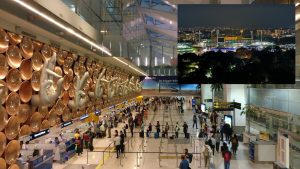
MELBOURNE, 23 August 2023: There is nothing like a direct flight to India. No stopping on the way, no extra expenses at airports, and same day reaching the destination. The Air India direct flight to New Delhi departing from Melbourne at 8 am (AEST) lands in Delhi same day at 4.05 pm (IST). Qantas also has direct flights. No doubt, these are popular flights much sought after by passengers despite the expenses. An indirect flight stopping for a few hours in Singapore or Kuala Lumpur (Malaysia) among others is the other alternative.
The rising numbers of the Indian Diaspora in Victoria has skyrocketed the demand for direct flights to India. Interestingly, the availability of seats on direct flights is around 80,000 and the estimated demand is around 275,000, says a new Australia India Institute’s (AII) ‘Aana Jaana’ report (Policy Brief) prepared for the Victoria Government by Dr Surjeet Dhanji and Dr Karen Barker. Though post pandemic travel is yet to reach the pre pandemic level, direct flights are a game-changer as they reduce flying time significantly.
The four routes offered, the report says, by Air India and Qantas are:
1. Air India Melbourne to Delhi Flights (MEL-DEL) 2. Air India Sydney to Delhi Flights (SYD-DEL) 3. Qantas Sydney to Bangalore Flights (SYD-BLR) 4. Qantas Melbourne to Delhi Flights (MEL-DEL) (All these non-stop flights to India from Australia also fly to Australia from India.) Air India started operating direct daily flights between India and Australia from 29 August 2022.
Air India (run by Tata) will be the first airline to fly the new Boeing-787 Dreamliner to Australia. The benefits of these flights is, ” Direct Air India flights are an example of the strength in the Australia-India relationship, and the rapidly expanding people-to-people links between Australia and India. • It is expected that Indian visitor numbers to Australia to nearly double by 2030. • Direct flights will benefit many Indian business travellers, students, migrants, tourists and families (VFR).”
Still, “The number and locations of connecting airports across India: Outbound direct routes are directed to very few major cities, predominantly Delhi, although Qantas has recently launched a non-stop flight between Sydney and Bengaluru. Flights are reaching only a small proportion of the potential direct market. There are opportunities to expand direct routes to other major Indian cities, which can be expected to create new demand and not just redirect existing demand.
So, why can’t there be more direct flights to and from India. Insiders say because of bilateral regulations by India and Australia, and other countries increasing direct flight seats is unlikely. For example, Malaysian Airlines, Thai or Emirates flights to India go via their own cities. It is a business decision to have indirect flights that benefits the airlines country of origin.
” India is the fastest growing international visitor market to return to Victoria following the reopening of Australia’s international borders. Already there has been 87,330 Indian visitors to Victoria in the year to August 2022, reaching 44 per cent of pre-pandemic levels.8 Prior to the COVID-19 pandemic, India was among the top five countries for international visitors to Victoria, with the number of Indian visitors doubling in the five years from 2014 to 2019. In 2019, Melbourne was the destination of almost 40 per cent of all Indian visitors to Australia. That year, Victoria welcomed an estimated 173,000 overnight visitors from India, who spent 8.1 million nights, and $508 million on visits, including $28 million on visits to regional Victoria, The AII report says.
Despite the big market the report admits “Securing direct flight routes is no easy task. It requires coordination and agreement amongst multiple stakeholder groups, including Indian and Australian airlines and code-share partners, airports, CAPA Centre for Aviation, state governments and tourism organisations.”
Till more seats on direct flights to India increase, the AII report recommends, different airlines can increase seats in indirect flights. “Low-cost carriers can help to expand market demand and Indian destinations. In India’s price-sensitive and segmented market, the Low-Cost Carriers (LCCs) present an attractive low-cost option that appeals to business travellers, VFR, and students. These LCCs operate connecting routes on airlines such as Scoot, Tigerair, Malaysia Airlines, Thai Airways International, AirAsia, Jetstar, and Sri Lankan Airlines., ” the report says.
Whatever be the mode of the flights, the Indian market is surging. Direct flights are more in demand. As the festival season arrives, the demand for indirect flights will also jump. Also, everyone cannot afford ‘business class’ travel. The cost of indirect flights are also exorbitant, a consequence of the regulated system.
Meanwhile, the hint is Air India and Qantas could ‘include more direct services.’ The proof of the pudding is in the eating.




